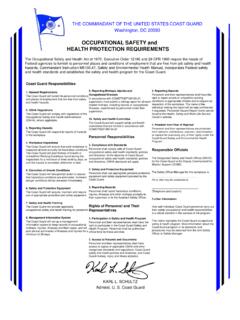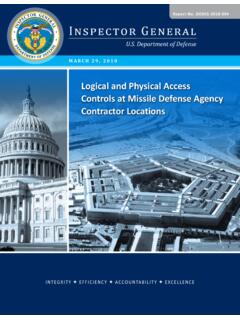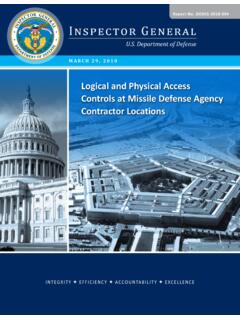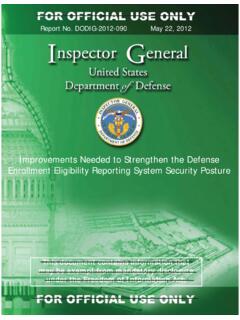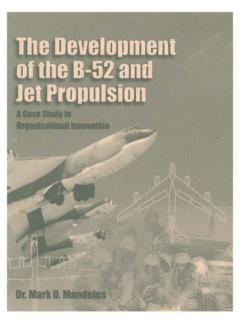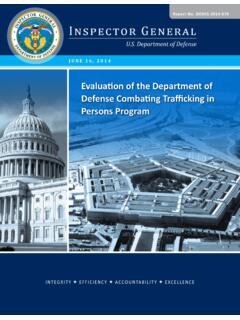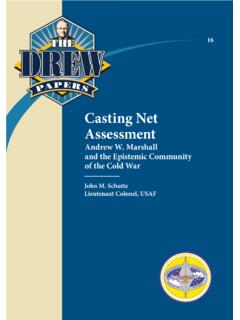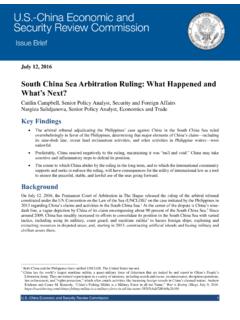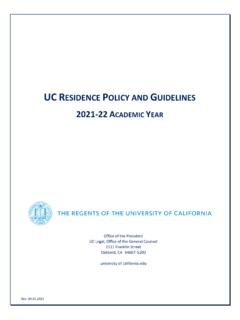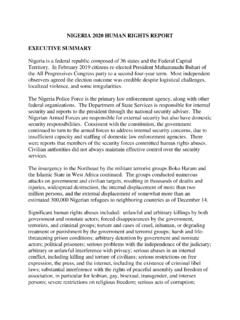Transcription of NAVPLAN - U.S. Department of Defense
1 NAVPLANCNOJ anuary 2021 January 2021 IntroductionIntroductionThe Navy s strategic direction remains clear. We are engaged in a long-term competition that threatens our security and way of life. As part of the Joint Force, we will meet this challenge by deploying forward alongside our allies and partners to deter aggression and preserve freedom of the seas. This Navigation Plan charts the course for how we will execute the Tri-Service maritime Strategy. It supersedes Design and informs my annual guidance for the Program Objective Memorandum and an internal implementation framework. It outlines the challenges we face, our unique role in meeting those challenges, and four priorities to focus our efforts: readiness, capabilities, capacity, and our Sailors. There is no time to waste our actions in this decade will set the maritime balance of power for the rest of the larger, more lethal, more ready fleet manned by the world's greatest Sailors is required to maintain our advantage at sea and protect America for years to come.
2 We will deliver, operate, and maintain that Navy with a focus on our core roles of sea control and power 2021 NAVPLAN 202122 The Growing Threat to AmericanThe Growing Threat to AmericanFor 245 years, our Navy has operated forward to protect commerce and keep fights far from our shores. Since the end of World War II, we have sailed with like-minded navies to uphold the rules-based order at sea. Together, we have provided stability, deterred great power war, preserved peace, and ushered in prosperity for billions of people across the world. Now our collective security and way of life are under threat. Today, China and Russia are undermining the free and open conditions at sea that have benefited so many for so long. Optimism that they might become responsible partners has given way to recognition that they are determined rivals. Both nations are attempting to unfairly control access to valuable sea-based resources outside their home waters.
3 Both intimidate their neighbors and enforce unlawful claims with the threat of force. Both have constructed sophisticated networks of sensors and long-range missiles to hold important waterways at risk. And both are turning incremental gains into long-term advantages such as militarizing contested features in the South China achieve its strategic goals, China is aggressively building a navy to rival our own. Already possessing the world s largest fleet, China continues to build modern surface combatants, submarines, aircraft carriers, amphibious assault ships, and next-generation fighters. Operating under the cover of the world s largest missile force, the People s Liberation Army Navy (PLAN) deploys alongside the Chinese Coast Guard and maritime militia to harass global shipping and exert pressure on regional countries below the level of traditional armed conflict. They have strengthened all dimensions of their military power to challenge us and our allies and partners from the seabed to space and in the information domain.
4 Now, they are extending their infrastructure across the globe to control access to critical waterways. Their concerted efforts to challenge our advantages make China our most pressing long-term strategic threat. Russia is also modernizing its forces. In addition to modernizing its strategic nuclear forces, Russia is developing modern missile frigates, fighter and bomber aircraft, hypersonic missiles, tactical nuclear weapons, and modern submarines. The Russian Navy is expanding its operations globally and deploying closer to our shores. Meanwhile, they continue to attack our computer networks. In a conflict, we expect they will threaten cyber or kinetic strikes against the homeland. Left unchecked, Russia will continue to undermine the rules-based order and threaten our is a maritime nation our security and prosperity depend on the seas. Failing to maintain our advantage at sea will leave America vulnerable.
5 We have to move decisively and do it and ProsperitySecurity and ProsperityNAVPLAN 2021 NAVPLAN 2021 America And our allies and protectAmerica And our allies and protectOur Response: Deploy Forward to DefendOur Response: Deploy Forward to DefendFor America to retain control of the seas, we must maintain a clear-eyed resolve to compete, deter, and win today while accelerating the development of a larger, more lethal future fleet. We must do so while integrating more closely with the Marine Corps and Coast Guard to generate Integrated All-Domain Naval Power. The Navy operating within the Joint Force plays a vital part in addressing the challenges posed by long-term competition with China and Russia. Deployed forward, we provide leaders quick response options for nearly any challenge from confronting rivals to helping local populations recover from natural disasters. Our combat-credible presence creates and maintains influence abroad, and ensures critical waterways remain open for commerce.
6 Our ballistic missile submarines provide an assured strategic deterrent that protects the homeland from nuclear attack. Our special operations teams are poised for early phase operations to keep our competitors off guard. When conflicts unfold, our forces are often first on the scene, and we can quickly scale forces to control the seas and project power ashore. After hostilities cease, we persist forward to preserve long-term interests through sustained forward engagement. We are a flexible, forward-postured force that competes and wins in the day-to-day, in crisis, and if need be in of the seasfreedom of the seas33 NAVPLAN 2021 NAVPLAN 202144 American security rests upon our ability to control the seas and project power ashore. For decades, our forces enjoyed the luxury of operating in permissive environments across the world. That is no longer the case. For the first time in a generation, the seas are contested.
7 We must stand ready to control them at the time and place of our choosing. Sea control provides the Joint Force freedom to maneuver and strike, protects friendly shipping, and denies use of the sea to our adversaries. In our digital age, it also means fighting our adversaries in space, cyberspace, and along the electromagnetic (EM) spectrum. Successful modern sea control demands the all-domain power of our Navy and the Joint Force. Our Navy must also be able to influence events ashore. This starts with deterring a nuclear attack against our nation with our ballistic missile submarines the most survivable leg of the nuclear triad. Projecting power and influence from the seas is vital to deterring aggression and resolving crises on acceptable terms. Projecting power and influence ranges from launching strikes against adversary forces to shaping the battle well left of launch and demonstrating to a competitor they have no viable means of achieving their objectives.
8 Naval forces field capabilities in all-domains to deter aggression - employing information warfare, cyber capabilities and special operations to a host of conventional weapons launched from under, on, and above the sea. Our power projection capabilities alongside our strategic deterrent provide the surest guarantee of security for America and our allies and partners. While America s need for sea control and power projection hasn t changed, how we compete and what we fight with has. Emerging technologies have expanded the modern fight at sea into all domains and made contested spaces more lethal. Ubiquitous and persistent sensors, advanced battle networks, and weapons of increasing range and speed have driven us to a more dispersed type of fight. Advances in artificial intelligence and machine learning (AI/ML) have increased the importance of achieving decision superiority in combat.
9 Additionally, advances in autonomous systems have shown promise for an effective and affordable way for the Navy to fight and win in contested spaces. We will modernize the fleet to harness these technologies and maintain our advantage at protect the homeland, preserve freedom of the seas, and deter aggression, our Navy will remain ready to control the seas and project power ashore. We will master new technologies and adapt the way we 2021 NAVPLAN 2021 Our naval power is amplified by sailing and integrating with like-minded navies. We must continue to strengthen our alliances and partnerships to ensure our success across the continuum of day-to-day competition, crisis, and conflict. We must continue operating interchangeably with key allies to expand the reach and lethality of our collective forces across the globe. Our robust constellation of allies and partners remains a critical strategic advantage over our , we have to do more than simply employ new capabilities we must compete in new ways.
10 This includes countering our rivals malign activities through effective day-to-day competition. To prevail in day-to-day competition, we will operate forward and take a more assertive posture in daily operations. We will challenge excessive maritime claims by sailing and flying wherever international law allows. We will also expand our information and decision advantage by persistently monitoring activities at sea in order to confront and expose malign actors. If necessary, we will continue to gain and hold competitor warfighting capabilities at risk before conventional conflict occurs. Finally, we will continue to dynamically deploy combat-credible forces to deter our rivals from making incremental gains and to demonstrate to our allies and partners our consistent commitment to a rules-based deterrence fail we stand ready to confront aggression and decisively win the fight.
